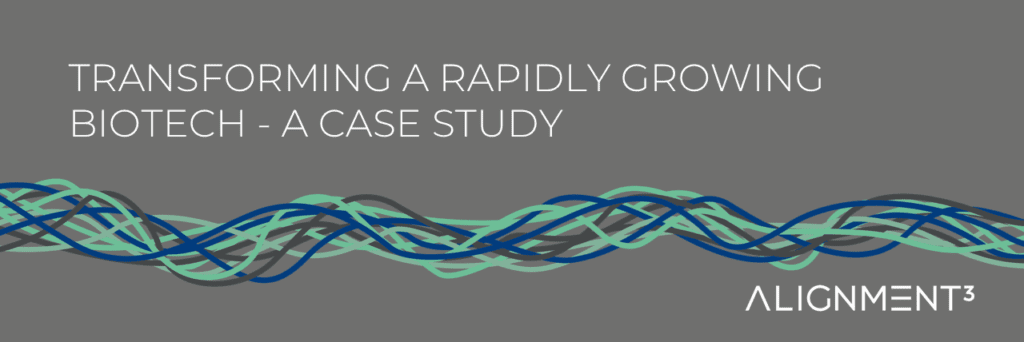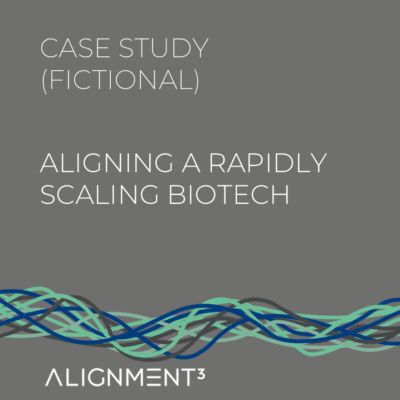Inspired by real-life events.

Background:
A biotech start-up, which had rapidly grown to 105 employees, was on the brink of chaos. With nearly $50 million in Series B funding, the company had cutting-edge technology, top-tier talent, and a vibrant, innovative atmosphere. Yet, despite the external perception of success, internally, the company was plagued by an ever-growing list of problems.
Leaders had differing visions. Ranging from drug discovery to cell therapy to building a machine-learning-powered database. Each leader pushed their agenda without being transparent or explicit. An artificial harmony at the executive level caused escalating arguments further down the hierarchy. This lack of alignment meant projects were stalled, money was haemorrhaging, and staff were burnt out. The climate oscillated between excitement and anxiety, with no consistent direction.
Challenges:
The organisation displayed symptoms typical of misalignment, including:
- Conflicting Leadership Priorities: creating confusion throughout the company.
- No Decision-Making Processes: Some decisions were made hastily, while others languished for months.
- Silos and Power Struggles: Departments operated in silos, and certain individuals held all the power and influence, creating an atmosphere of office politics.
- Frustration with Processes: The introduction of new processes, such as ISO9001, was met with severe resistance due to inconsistent communication from leadership.
- Burnout and Overload: Employees felt overwhelmed by competing priorities, frequent changes in direction, and a lack of clarity around roles and responsibilities.
Overall, staff felt miserable knowing that they couldn’t achieve their own nor the company’s true potential.
Intervention
It became clear that the company needed help. Two former biotech leaders turned consultants were brought in to conduct an assessment. They identified that the root cause of these issues was a profound misalignment within the organisation. What followed was an accelerated pathway to organisational alignment.
Stage 1 – Attune: Improving Leadership Cohesion
In the Attune phase the consultants worked with the executive team to explore and enhance psychological safety and build vulnerability-based trust. Through a combination of one-on-one conversations and group discussions, they created a space where leaders felt safe to speak open and honestly – creating the conditions for healthier dialogue that forges stronger alignment.
They also used an innovative assessment to quickly identify individual key strengths and frustrations, accelerating self-awareness and cohesion within the leadership team. For the very first time, they began supporting each other as a single, unified team.
Stage 2 – Articulate: Bringing Organisational Clarity
In the Articulate phase the consultants co-created the Organisational Context Page (OCP) over a two-day workshop with the executive team. This single-page document established context specific, solid foundations. It defined the company’s entire identity and strategic framework, in a way that was simple and actionable.
The OCP became the cornerstone of all decision-making, ensuring that everyone in the organisation was aligned on the big-picture goals and trade-offs. This clarity empowered teams to act autonomously, seeing how their role contributes and knowing that their actions align and serve the company’s long-term vision.
Stage 3 – Activate: Establishing Execution Architecture
With the leadership aligned and the OCP in place, the consultants turned their attention to working with the employees to co-create the execution architecture over the next 12 months. They systematically worked through the entire organisation, ensuring that the organisational capabilities, architecture, and management systems reflected the company’s new direction.
- Organisational Capabilities: They ensured that the company’s technology, talent, and intellectual property were optimised. Focusing on agility, innovation, and collaboration, as agreed within the OCP.
- Organisational Architecture: They realigned the structure to foster connectivity and collaboration across teams. They introduced meeting structures that supported rapid iteration and flexible project management, while still maintaining enough process to prevent chaos.
- Management Systems: They worked with the staff to realign the management systems across IT, Quality Assurance, Health & Safety, and Finance, ensuring that these systems supported the company’s strategic goals without creating unnecessary bureaucracy.
Throughout this stage, they worked closely with key members of staff acting as facilitators and guides so that the internal competencies grew alongside the management systems creating a sense of ownership and commitment. This ensured the systems could be sustained long after the consultants had left.
Results:
The impact was profound:
- The company’s Organisational Alignment Index (OAI) score increased from 20% to 70%.
- Decision-making processes were clarified, and the cash haemorrhage was stopped, allowing the company to regain control over its finances.
- Employee engagement scores significantly improved – particularly in the areas of meaning, autonomy, growth, impact, and connection.
- Productivity increased by 40%, and the rate of employee attrition dropped below the UK average.
- The overall culture improved. From an absence of manipulative power politics to an atmosphere of psychological safety, the staff frequently commented on how things felt positively different.
- In time, after the consultants’ departure, the company would successfully secure Series C funding.
Conclusion:
The journey from chaos to alignment at this biotech company illustrates the transformative power of the accelerated Alignment Cubed Pathway. By focusing on Leadership Cohesion, Organisational Clarity, and Execution Architecture, the consultants helped the company develop into a high-performing, collaborative network, aligned with the leadership’s vision and positioned for long-term growth.
Alignment Cubed supports busy biotech CEOs, providing an accelerated pathway to achieve Organisational Alignment as their company scales and becomes more complex, and priorities conflict. To find out how we can support you, contact Jonathan or Majid.
Back

